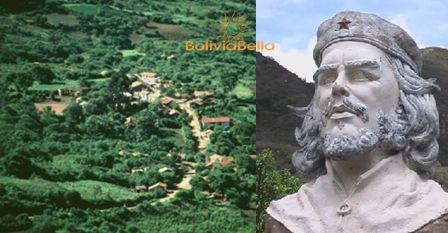|
La Higuera in Santa Cruz Bolivia La Higuera is a town so small, it would not appear on maps if not for its one claim to fame: it is here that Ernesto “Che” Guevara was executed in the town schoolhouse on October 9th, 1967.
Located about 90 miles Southwest of the city of Santa Cruz, it has just over 100 inhabitants (about 15 families), most of them Guaraní, who live from the land and raise a small quantity of animals. Che Guevara had chosen Bolivia as his “central hub” believing it would be easy to spread socialism throughout South America from here. He and his guerrilla warriors hid out in the Bolivian Chaco region in towns nearby like Vallegrande and Camiri. Che was shot about 4 kilometers from town at Quebrada del Yuro and limped back to La Higuera, injured. Here he was caught and killed. After his execution his body was taken to Vallegrande for viewing in the laundry room of a small medical center by the international press before mysteriously disappearing. It was found again 30 years later under an airstrip and sent back to his family in Cuba. Since then, Bolivia has made the “Ruta del Che" a very popular tourist attraction. It is a tour of the towns and locations traversed by the Che which also includes stops in Pucara and Mataral. La Higuera is one of the stops along this Che Guevara Tour. In addition, in 2007 on the 9th of October, thousands of followers and interested tourists converged upon tiny La Higuera and nearby Vallegrande to commemorate the 40th anniversary since his death. There was a lot of national and international media presence as well. It's become a kind of a religious pilgrimage. People build altars to him, light candles in the church, and some even call him "Saint Che" and "San Ernesto". An enormous bust of the Che dwarfs the tiny central plaza. Forty years after his death, the townspeople petitioned for the town's name to be changed. It is now, officially "La Higuera del Che". Incidentally "la higuera" means "fig tree". In Spanish figs are "higos". The Ground Opens Up in La HigueraIn April 2008 inhabitants of La Higuera, 25 kilometers West of Vallegrande were forced to abandon their homes due to the appearance of enormous growing cracks in the soil which caused six (of the town's roughly 15) homes to crumble to the ground. This geological process, which began during the first week of April, did not initially worry the town's 149 inhabitants; however, cracks began to appear in the walls of several homes and the latter eventually came down. Several authorities visited the area to report on this strange occurrence and convinced many of the town's inhabitants to seek shelter in a nearby parish hall until a solution could be found for this town which is now filled with deep and very dangerous crags and holes. The mayor indicated nothing of this nature had ever been seen in the area before. The San Calixto Observatory indicated that no seismic movement had been recorded in the area and therefore it is believed the cracks occurred because the earth was overly saturated by underground water.     |
